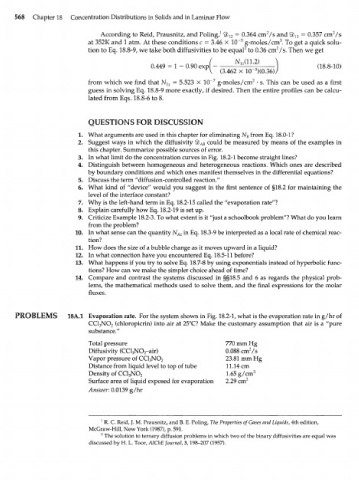Page 588 - Bird R.B. Transport phenomena
P. 588
568 Chapter 18 Concentration Distributions in Solids and in Laminar Flow
2
2
According to Reid, Prausnitz, and Poling, 1 3> = 0.364 cm /s and 2) 13 = 0.357 cm /s
12
3
5
at 352K and 1 atm. At these conditions с = 3.46 X 10~ g-moles/cm . To get a quick solu-
2
tion to Eq. 18.8-9, we take both diffusivities to be equal 2 to 0.36 cm /s. Then we get
0.449 = 1 - 0.90 exp( N (11.2) j (18.8-10)
l2
э
4 (3.462 X 1(Г )(0.36)/
7
from which we find that N lz = 5.523 X 10~ g-moles/cm 2 • s. This can be used as a first
guess in solving Eq. 18.8-9 more exactly, if desired. Then the entire profiles can be calcu-
lated from Eqs. 18.8-6 to 8.
QUESTIONS FOR DISCUSSION
1. What arguments are used in this chapter for eliminating N from Eq. 18.0-1?
B
2. Suggest ways in which the diffusivity ЯЬ АВ could be measured by means of the examples in
this chapter. Summarize possible sources of error.
3. In what limit do the concentration curves in Fig. 18.2-1 become straight lines?
4. Distinguish between homogeneous and heterogeneous reactions. Which ones are described
by boundary conditions and which ones manifest themselves in the differential equations?
5. Discuss the term "diffusion-controlled reaction/'
6. What kind of "device" would you suggest in the first sentence of §18.2 for maintaining the
level of the interface constant?
7. Why is the left-hand term in Eq. 18.2-15 called the "evaporation rate"?
8. Explain carefully how Eq. 18.2-19 is set up.
9. Criticize Example 18.2-3. To what extent is it "just a schoolbook problem"? What do you learn
from the problem?
10. In what sense can the quantity N Az in Eq. 18.3-9 be interpreted as a local rate of chemical reac-
tion?
11. How does the size of a bubble change as it moves upward in a liquid?
12. In what connection have you encountered Eq. 18.5-11 before?
13. What happens if you try to solve Eq. 18.7-8 by using exponentials instead of hyperbolic func-
tions? How can we make the simpler choice ahead of time?
14. Compare and contrast the systems discussed in §§18.5 and 6 as regards the physical prob-
lems, the mathematical methods used to solve them, and the final expressions for the molar
fluxes.
PROBLEMS 18A.1 Evaporation rate. For the system shown in Fig. 18.2-1, what is the evaporation rate in g/hr of
CC1 NO 2 (chloropicrin) into air at 25°C? Make the customary assumption that air is a "pure
3
substance."
Total pressure 770 mm Hg
2
Diffusivity (CCl NO -air) 0.088 cm /s
2
3
Vapor pressure of CC1 NO 2 23.81 mm Hg
3
Distance from liquid level to top of tube 11.14 cm
Density of CC1 NO 2 1.65 g/cm 3
3
Surface area of liquid exposed for evaporation 2.29 cm 2
Answer: 0.0139 g/hr
1
R. С Reid, J. M. Prausnitz, and В. Е. Poling, The Properties of Gases and Liquids, 4th edition,
McGraw-Hill, New York (1987), p. 591.
2
The solution to ternary diffusion problems in which two of the binary diffusivities are equal was
discussed by H. L. Toor, AIChE Journal 3,198-207 (1957).

